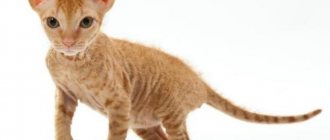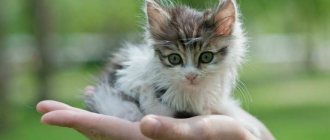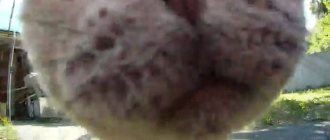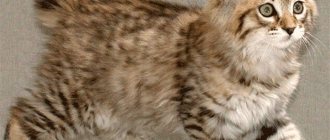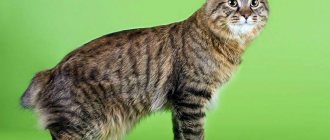It’s no wonder that Kurilian Bobtail cats are rapidly gaining popularity. Those who desperately want to have a pet should definitely pay attention to these charming, dog-like devoted pets, because their character is ideal for keeping at home, and the high intelligence of Kurbobs makes them obedient and easy to train.
Description of the Kurilian Bobtail breed
Popularity 77th place among 86 cat breeds
Lifespan:
12-15 years
Height:
up to 30 cm
Country of origin:
Russia
Average price:
10-20 thousand rubles
Weight:
up to 7.5 kg
Latest articles Cat care
How to trim a cat's claws correctly and easily 01/28/2022 139 0 0
Dog health
How to do an ultrasound for dogs: preparation and procedure 01/28/2022 63 0 0
Training, education
Dogs are animals. Living beings need to exercise instincts. Domesticated animals are trained to do this safely. Training requires diligence, regularity, and work.
Each breed is special. There are dogs prone to aggression. These facts are taken into account in advance. Dogs are taught calm behavior.
A pet has its own place. A rug, a bed, a dog house will do. A disobedient pet that has misbehaved is sent to its place in a stern voice. The beast respects authority. You'll have to subdue your pet. The biting fidget is taken by the scruff of the neck and pressed to the floor. Authority is a manifestation of strength.
Training is accompanied by the distribution of treats. Correctly completed tasks are rewarded with delicious food. Regular exercise develops reflexes and habits. The dog becomes obedient.
Key facts
The main characteristic of the Kurilian Bobtail is its tail. Outwardly, it resembles a fur ball. This trait was inherited by the breed from its Japanese neighbors.
Despite the fact that cats are proud creatures by nature, they are seriously attached to the family in which they live, but they can only have one owner. Do not pay attention to the similarity of these cats with wild predators. They are friendly and playful by nature.
Bobtails will only be welcome for children in the house. Don't want your child to be bored alone? The Kurilian Bobtail cat will take part in any game. Bobtails also treat other pets leniently, however, given their cat-like nature, you should still not let ornamental birds or rodents get close to them.
Be prepared for the fact that from time to time the bobtail will test your nerves and show excessive nobility and willfulness. Do not succumb to the furry's provocations, otherwise he will lose respect for you. The description of the Kuril Bobtail breed explains its dominance by the conditions in which the breed was bred.
The health and life expectancy of the Kuril Bobtail are encouraging: seals live up to 15 years, and there are also those individuals that have reached the 17-18 year mark.
Feeding
Pay careful attention to the issue of the animal’s nutrition, as its imbalance can lead to upset of the Kurilian Bobtail’s digestive system. It's up to you to feed him natural products or buy food in specialized stores. Just make sure that the food is of high quality.
It is believed that the optimal food for bobtails is hard food: poultry stomachs, various bones and cartilage. When feeding, you need to take into account that Kuril bobtails are a wild hunting species, and their diet should be as close to natural as possible.
Make sure your pet has easy access to clean drinking water.
History of the origin of the Kuril Bobtail
The southern part of the Kuril Islands is a well-known place. For many years, Japan and Russia defended their rights in this territory. However, the Russian Federation still remained their rightful owner. The country received not only a piece of land in the Far East, but also the right to be considered the homeland of one of the most unusual cat breeds.
Most felinologists believe that bobtails descended from those short-tailed cats that inhabited the islands since the 18th century. Their distant relatives were wild cats, which appeared thanks to the union of Siberian cats and Japanese bobtails. Their story also deserves special attention.
In Japan, bobtails are considered a symbol of good luck, as evidenced by ancient beliefs. People treat representatives of this breed with respect, give them to each other on major holidays, and sometimes even overprotect them. The origin of these animals is no less sacred. Their ancestors are considered to be white cats that lived in temples and guarded the followers of Buddha.
The Japanese often brought their animals to the Kuril Islands as part of military or other expeditions. They were even used as guards on farms where fur-bearing animals were bred. However, cats are not animals that will obey in everything. They are too proud for this. It is for this reason that many Japanese bobtails simply ran away from their owners into the wild nature of the Kuril Islands.
Generations passed, and bobtails acquired new features that helped them adapt to the harsh nature. Now these cats were no longer afraid of water, their claws were no longer hidden in soft paws, and the animals themselves became much larger, which allowed them to hunt larger game.
Siberian cats came to these lands along with settlers. They made friends surprisingly easily with their Japanese brothers, who by that time had completely gone wild. Time passed, the breeds mixed until the familiar Kuril Bobtails saw the light of day.
However, local residents did not immediately notice that a new breed had formed literally before their eyes. Therefore, the selection of Kuril Bobtail cats began a little later. Felinologists paid attention to the Kurilians only towards the end of the 20th century. Until this time, bobtails were mistaken for Japanese cats. No one knew then that those same furry creatures were not just feral cats from the Land of the Rising Sun, but truly something new in the already diverse fauna of the earth. But in 1991 everything changed dramatically.
At this time, the first breed standard was formed from cats brought from the Kuril Islands by the Soviet felinological organization. Tatyana Bocharova played an important role in this. She conducted research and found that the short tail of the bobtail is inherited by absolutely all descendants, which means that this is not a genetic anomaly, but a full-fledged feature of the breed.
So Kuril cats were officially registered as a separate breed in the Siberian Federal District. However, this was not enough. Now there was another question - how to achieve recognition from European organizations?
In 1994, a seminar was held at which Russian breeders asked how to refine the breed standards and achieve recognition from the international organization WCF. A year later, the breed received its recognition, and with it an explosive flurry of interest among Europeans. Bobtails have become frequent guests of exhibitions in the Czech Republic, Poland, Italy and many other countries. Nurseries opened everywhere, breeding both short-haired representatives of the breed and long-haired ones. However, the long-haired representatives quickly divided into cats with long and semi-long hair.
In 2001, the standard of the Kuril Bobtail was once again clarified, but overall remained unchanged. In 2012, the FIFe organization officially approved the independent Kuril Bobtail breed. In the same year, the breed appeared on the TICA lists.
To this day, bobtails appear in more and more places, winning the hearts of more and more people. These cats are highly valued in Europe for their kindness and devotion, and in the east, bobtails have become integral companions of hunters and fishermen, who were able to fully appreciate the hunting qualities of fluffy cats.
CHAPTER II. RAISING A CAT
- Grooming
- Bathing a cat
- How to stop a cat from sharpening its claws on furniture
- Nail trimming
- Toilet
- Accustoming a cat to a harness and leash
The condition of a cat's fur is an important indicator of its health. Grooming is necessary for all cats, regardless of coat length. Brushing is also a massage that improves the general condition of the animal. Daily brushing of long-haired cats is simply necessary, otherwise the old hair will fall off and form tangles, which will then have to be trimmed with scissors. You need to get special combs and brushes, wash and disinfect them periodically. Plastic combs are undesirable because they electrify the fur, which is very unpleasant for the cat. It is necessary to start accustoming a kitten to the process of combing as early as possible, so as not to later fight with an adult and strong animal (Fig. 7).
Rice. 7. You need to accustom a kitten to a comb from a very early age (Maxwell the cat)
Bathing a cat is not an easy task, so everything will depend on its character. Some cats get very excited and become aggressive during bathing, while others enjoy this procedure. It is now recommended that cats be taught to bathe from an early age in order to develop a positive attitude towards this procedure.
It is most convenient to bathe in a bathtub (so that the cat cannot jump out), using mild detergents. Water should not get into the ears; to do this, when washing your hair, the shower is directed from behind. Washing your hair is an unpleasant moment for your cat and should be left until the very end of the bath. The wool must be thoroughly washed so that no traces of soap or shampoo remain, as it is then thoroughly licked. Dry the cat with a soft towel and, if it does not resist, dry it with a hairdryer.
Good grooming of a cat's coat (especially shorthaired cats) will minimize the need for bathing. It is necessary to bathe a cat only in rare cases when it is necessary to keep the coat clean and smell nice (for example, before a show). In general, the frequency of bathing depends on the cat's coat type, color, and regularity of general grooming. Frequent bathing can lead to dry skin, dandruff and irritation. Use cat shampoo.
Sharpening their claws is a normal natural need for cats, an absolutely necessary procedure for them. With this procedure, the cat gets rid of the dead upper layer on the bones of the front legs. She processes her hind claws with her teeth. It is almost impossible to stop her from sharpening her nails. There are 3 ways to avoid trouble.
1. The most traditional. Buy a post for your cat's claw point. You can independently make special “grinding trees” with soft wood, boards covered with coarse fabric or old carpet and attached to the walls at the height of a cat’s height.
2. Nail trimming. This method is good for an indoor cat that does not go outside and is not at risk of fights with other cats or attacks by dogs, as well as many other troubles. A cat's claws are the first weapon of defense.
3. Surgical declawing. A rather complicated method, which is resorted to as a last resort. You can ask your veterinarian about this.
Nails need to be trimmed only if they reach excessive length. This will not happen if the cat moves a lot, runs, climbs trees: the claws will sharpen and shorten themselves. Cats that do not like or cannot move much due to illness, old age or because they are kept indoors have too long claws and therefore have nothing left to do but sharpen their claws on our furniture and carpets, which, of course, The owners don't like it. The cat can even bite off the claws on its hind paws, scraping off dead scales.
A cat's fifth claw is located on the back of its front paws, just above its toes. It never scratches on anything and grows freely, so that in older cats it bends into a ring and can also pierce the skin.
You should regularly check the length of your pet's nails. The claws on the hind paws are shorter than those on the front paws. Therefore, they usually trim the cat’s claws only on the front paws.
If the claws are devoid of pigment (transparent), then underneath you can see pink blood vessels that reach right to their tips. If the blood vessel does not reach the tip of the nail, the nail is very long and the veterinarian can easily trim it without fear of damaging the blood vessel. If the claw is pigmented, then the nail trimming process will be more difficult for you. If the blood vessel is not visible under the black claw, then the cutting location is determined following your already acquired experience. Be sure to remember that as the claw grows, the vessel also lengthens, so if you cut the claw to a “normal” length, it is possible that you can damage the vessel and thereby cause bleeding. It is better if you trim the claw so that it is slightly longer than usual. Then the nail should be trimmed again after 2 weeks.
Have someone help you hold the cat tightly. Trim the claws on your paws one at a time. With your index finger, grab the cat's paw pad from underneath the claw, and with your thumb, the skin on top of the claw, and squeeze your fingers lightly. In this case, the claws will appear from the pads. Make a neat cut across the claw, but not diagonally. Once you've finished cutting your nails, you can polish the sharp edges with a nail file or sandpaper.
If bleeding occurs, it can be quickly stopped with a styptic pencil. You can also attach a piece of cloth or sprinkle with talcum powder or flour. Often, to stop mild bleeding, it is enough to press the claw into a bar of soap. If bleeding is severe, you will need to apply a pressure bandage and contact your veterinarian.
A haircut is also necessary in cases where the claw is broken and a piece of it is dangling at the end. You then need to trim this piece completely. And if there is bleeding, then you need to do as described above. However, you should not trim your nails just to protect the furniture, as this will only help partly. In order to get rid of this, you just need to train your cat to sharpen its claws on a scratching post.
In advertisements for the sale of kittens, you can often see the phrase “toilet trained” - then there is nothing to worry about. All you have to do is ask the owners in detail about what they mean. For example, our cat was trained not to go to a litter tray at all, but to go to newspaper, which led to not entirely pleasant consequences. The kitten found a newspaper tucked behind the refrigerator and ran there for about a week, and we were perplexed: the kitten didn’t go to the toilet, probably got sick.
If the kitten has no idea about the toilet, you should pay close attention to this. But the process of toilet training a kitten is actually not as difficult as it seems at first glance. It will be just great if you take a kitten into your home when it is very young. Toilet training or retraining an adult animal is much more difficult.
Let's start with how best to organize supervision of a pet, because without this the learning process will be too long and intermittent. The best thing is to adopt a kitten during the period when you are on vacation, vacation, holidays, or (at worst) do it on weekends. Then you will have the opportunity to track your pet’s actions and adjust them accordingly. Treat the kitten as a small, unintelligent child; under no circumstances hit, spank, or scream at it if it stains the floor.
At first, just silently take him to the toilet. If, after a week of knowing you, the kitten continues to ignore the litter box, talk to him in a stern tone (but without screaming!). Show him the pile, hold him next to it and say: “What is this? Who did this? You can’t do that!” After this, take the kitten to the toilet, show him the tray, move the litter - let him rummage in it.
Remember that a cat’s body is designed in such a way that the process of eliminating natural needs sometimes follows immediately after feeding or a little later. Feed your kitten at the same time every day and try not to lose sight of him immediately after feeding. If he began to stir, began to look for a place to settle down, and began to sit on his hind legs, the process will almost certainly begin soon. At this moment, deftly grab your pet under the belly and transfer it to a tray with filler, make sure that the kitten does not leave the tray until it completes its task.
If you constantly and systematically repeat these actions, the kitten will very soon get used to them and begin to go to the toilet on their own. It's no secret that cats find the toilet by smell. This does not mean that the toilet does not need to be cleaned and disinfected. But if your pet pooped in the wrong place, remember that you should immediately wet clean and disinfect it, otherwise he will remember this corner and may continue to do his business there in the future. Use this opportunity to teach your kitten how to use the toilet. Take a cloth, wipe the floor and take the smelling cloth to the toilet. The kitten will sense the smell and “refocus” on the toilet.
Particular attention should be paid to the cleanliness and tidiness of the cat's litter box. Some cats are able to neatly make a pile next to the litter box if the litter box is untidy and dirty. In this case, you cannot scold the cat! You need to calmly remove what she has done, clean the toilet, take the cat in your arms and confront her with a fact - let her understand that you are not indifferent to her desire to remain clean. Cats understand our gestures perfectly.
While the kitten is still very small, treat it like a child. You shouldn't let him sleep in your bed because "trouble" can happen right there. Later, when the kitten learns to be neat and use the toilet correctly, you can gradually expand its territory and allow all sorts of liberties. I note that cats are incredibly clean by nature, they lick every lint, so it is not recommended to wash the kitten in the bathroom too often. Of course, if an incident occurs (stomach upset or it gets completely dirty and you can’t handle it), you can wash it, but, as experience shows, nature takes its toll, and with the right, calm and reasonable attitude, kittens quickly and easily get used to using the toilet and maintaining personal hygiene.
All cats love to walk. But walking with a cat without a leash is fraught with the most unexpected consequences, since in an unfamiliar place, even at a short distance from the owner, cats lose contact with him. In order to take your cat for safe walks, you need to accustom it to a harness and leash. This will allow you not only to release it in the park, but also to provide the necessary movement for the animal during long-term transportation in a car or train. Harnesses for cats are sold in pet stores and are made of elastic nylon tape with a soft felt lining. When buying it, make sure that it fits snugly to the animal’s body; only one of your fingers should fit under it.
Cat collars are used only as identification for the owner, and flea collars are also used.
You cannot attach a leash to a collar. Cats do not have as muscular a neck as dogs and will not be able to bear the strain. If a cat accidentally gets caught on something, it can suffocate or damage its delicate neck. Since cats do not know how to walk next to their owners, you should not lose sight of them for a minute.
To help your cat get used to the harness and feel comfortable, put the harness on the cat before feeding it or while playing with it. Then the cat will associate the presence of a foreign object on its body with something pleasant for it, and the process of eating or playing will distract it from the unusual sensations at first, and it will stop noticing it.
When going for the first walk in your cat’s life, choose in advance a secluded place in the park where the cat will not be scared by either dogs or a large crowd of strangers. To the place of the walk, you should carry the cat in a transport container, or at least in your arms, having previously put a harness on it and fastened a leash. When you arrive, place the container on the ground and open it. The cat will come out when it wants to, or gently release it from your arms. Bring a treat with you, and, holding your cat at length (but not taut) on the leash, call her to you.
If you forcefully pull a cat's leash, you can permanently instill in it an aversion to walking. The fundamental difference between walking a cat and walking a dog is that the cat will walk you. She will move wherever she wants, and you will slowly move behind her.
Recreational walks are contraindicated for cats until they are five months old, since they have not yet developed immunity and have not received all vaccinations; after the age of ten, if they have never walked before; during the rehabilitation period, regardless of age, after an illness or surgery; when estrus is expected in the near future or has already occurred, as well as during pregnancy; if the cat is extremely cowardly or aggressive.
Table of contents
What does a Kurilian Bobtail look like?
The appearance of the bobtail is contrasting. Although he is not tall enough, his muscles are the envy of any other cat. Thanks to its strong muscles, the animal can run very fast and make incredible jumps. It is very easy to distinguish a female bobtail from a male, because the breed has highly developed sexual dimorphism: males are several centimeters taller than females and 2-3 kilograms heavier. In the photo of the Kurilian Bobtail you can immediately see what gender the animal is.
Muzzle
The bobtail's head is triangular, with rounded corners. The whisker pads are well defined and quite dense. The skull is flat.
The muzzle is wide and round in shape. The stop is poorly marked and almost invisible. The forehead is flat, smoothly transitioning into a wide, short nose. Its lobe is quite large and well defined. The chin is strong, with smooth outlines that are clearly visible in profile. The cheekbones are low, but not as much as in Siberian cats.
The ears are triangular, not too large. Planted far apart, high. The distance between the ears should be equal to the width of the ear itself. It may be a little more, but less is unacceptable. At the tips of the ears there are small tassels-decorations. This gives them a lynx-like appearance.
The eyes are slightly slanted, inherited from their eastern ancestors. This gives them a unique aesthetic and mysterious look. The eyes are set quite wide, on the same line. The color of the iris can be green or yellow. In the case of two-color representatives, blue eyes are acceptable. Eye color is not strictly regulated by the standard.
During the time that Japanese bobtails lived in harsh Siberia, they acquired powerful jaws. Their bite is pincer-shaped, with a full set of teeth.
Body type
What does a Kurilian Bobtail look like? His neck is covered with thin skin, under which powerful muscles are hidden. Due to the compacted coat in this area, it appears that the bobtail has a wide neck.
The body is dense, strong, however, which is typical for all types of cats, very flexible and pliable. The body is elongated, the back is arched, the croup is slightly raised.
The main distinguishing feature of the bobtail is its tail. It rises above the back. Its length varies from 3 to 13 cm depending on the length of the animal’s fur. However, even such a short tail has 4 varieties:
- The “stump” is assembled from vertebrae tightly adjacent to each other. It can either be held straight or be bent down with a hook;
- “broom” – 5-10 vertebrae, straight. 1/3 smaller than a regular tail;
- “spiral” is one of the most common among bobtails;
- The “retracted bobtail” includes 5-7 vertebrae that curl into a loop towards the tip of the tail. Considered a defect.
The shape of the pompom itself is not limited in any way in the standard, so it can and even needs to be trimmed periodically. The varieties of the Kuril Bobtail are not distinguished on this basis.
The hind legs of bobtails are much longer than the front legs. Their developed muscles allow cats to jump long distances. Bobtail paws are round, with tightly clenched toes. The claws do not retract into the pads, which is why the cat makes a scratching sound when walking, characteristic of dogs.
Coat and color
Kurilian Bobtails are divided into two types based on the length of their coat:
- Short-haired representatives have fine wool. On the tail it may be longer than on the rest of the body.
- Long-haired cats, accordingly, have longer or medium-length hair. But even they may have longer hair in the lower part of the body and on the tail. In addition, they have a puffy “collar” and “pants”.
The color of the Kurilian Bobtail can be almost any color. There are several common varieties: smoke, tricolor and tabby. The breed standards do not include chocolate, lilac, Abyssinian and Burmesse colors.
Let's stop biting
It is easier to teach behavior to kids than to older dogs. Puppies are active, mobile, easily excitable, uncontrollable creatures. Such behavior in the absence of education becomes the norm. An untrained dog will be mischievous and do nasty things.
Puppies are babies. They need toys. If the baby has bitten an arm or leg, open the jaw and insert a toy. Biting people is prohibited! Household items and shoes are taken away. You can only play with toys. The little kitten will understand.
Punishments work. You can punish after the third month. Hitting, slapping with hands, or kicking is prohibited. Use a magazine, newspaper, toy. It is necessary to teach the dog prohibition commands. Disobedience is punished.
An animal that does not understand is ignored. After the bite the person leaves. If the dog bites, the game ends. The animal will understand that it hurts.
Character of the Kurilian Bobtail
Although Kurilian Bobtails may look wild, they are actually famous for their kindness and friendliness. Even with a change of owners, the bobtail quickly gets used to the new owners. He will not sit with a sad face under the bed until you pull him out of there, but on the contrary, he will come up to you to get acquainted.
These cats are active and love when all family members participate in games. Sometimes they look more like dogs: after all, they also like to fetch toys that the owner throws for them.
This cat will love his family as devotedly as a dog would. Nothing is more important to him than his family. The animal will protect the family by taking a threatening pose and meowing menacingly. Well, the owner of the bobtail has a special place. If you are lucky and a furry guard has chosen you as his owner, be proud of it. Now he will accompany you everywhere and become an integral part of your life.
The bobtail has no complaints about other pets. He will happily share his home with either another cat or a dog. However, this does not apply to birds and rodents, which the cat will perceive exclusively as prey. A suddenly heightened natural instinct can lead to unpleasant consequences.
Although this baby looks kind and harmless, be prepared for his outbursts of pride and independence. The bobtail will definitely not want to sit in your arms for a long time, because this is not a plush toy, but a real hunter. If the owner does not pay enough attention to the animal, then soon the cat will simply begin to live by its own rules, feeling like the master of the house.
If this happens, it will not be easy to overthrow the furry tyrant from his throne. You will encounter cat protest and harmfulness. He is unlikely to limit himself to torn curtains, damaged things and broken dishes. The character of the Kurilian Bobtail will deteriorate if the owner devotes insufficient time to raising it.
Has the cat become completely lazy and almost doesn’t want to play with you anymore? Take it with you on a hike or to the countryside! There you will see your pet in a completely different light. In the fresh air, the animal will quickly remember all its hunting roots. Now there will be no time to lie on the couch all day long, because you have to catch butterflies, fight with the neighbor’s cats, and explore the territory.
Character and behavior
The character traits of the Kurilian Bobtail lie in its canine fidelity and tendency to become attached to one person for life. The “friend” chosen by the cat is always enveloped in the attention of the pet, who tries to keep up with the person who managed to tame him and is very concerned about the fate of the owner. However, Kurils are capricious and prone to dominance. The hunting instinct speaks loudly in them, so active games and hunting are favorite habits for bobtails. But these predators also know how to listen and keep good company.
Attitude towards people and animals
Kurilian Bobtails are very friendly and sociable; they love to be in the family and consider themselves full members of it. Kurbobs treat familiar company with tenderness and sensitivity, and distinguish them well from strangers. They treat children with care and are categorically against aggression. With strangers everything is different. Kurilian bobtails are excellent protectors, although they are inferior to dogs, but they are ready to adequately stand up for their owner or home. They have a negative attitude towards violation of personal space by those they do not know, however, if the owner is calm, the bobtail will share it.
Cats love to walk on a leash.
Kuril gets along well with other cats or dogs if they recognize his leadership or prefer to remain on an equal footing with him. Aggression towards oneself will not frighten a bobtail, so it is better to limit it from contacts with animals that provoke the bobtail to fight for dominance. The smoker will perceive small animals only as objects of hunting, therefore, although he listens to the commands of his owner, you should not expect friendship between a predator and a chinchilla or hamster.
Training
Training and raising the Kurilian Bobtail does not cause any difficulties. Kurbobs are very smart, and quickly remember what they are allowed to do and what they are not allowed to do. Despite their penchant for originality, the master's word is law for them. Unlike some other species, during the process of raising these animals it is necessary to communicate with feeling and explain the rules of life in your home. However, it is very important to establish authority and not allow the smoker to imagine himself as the main one in the house. It is necessary to accustom a kitten to a litter box at a very early age. As a rule, his mother trains him, and his owner helps. Later, this task will be extremely difficult. Surprisingly, representatives of the Kuril Bobtail breed remember commands very well, and training will come in handy for them if they are in a good mood.
Raising a Kurilian Bobtail
Nature has not deprived bobtails of intelligence. A cat can not only guess your mood, but also understand what you are talking about. Raising such a cat is not difficult, but it is important to clearly define the boundaries. Do not hit the cat under any circumstances; it is better to explain to him that he is behaving inappropriately, in some other way. Teach him the word “no”. This will help you a lot in the future.
If your pet does violate any of the rules, have an educational conversation with him. It is important to do this as quickly as possible after committing a “crime”, otherwise the cat simply will not understand you.
As soon as the pet has matured, it begins to test the strength of its owner’s nerves and tries to take the place of the boss in the house. At this time, it is important to let him understand that you do not intend to give up your place to him, moreover, for disobedience he will be punished in the same way as always.
For people with a strong character, raising a bobtail will not cause any problems. The cat will quickly get used to the tray and scratching post and will not cause any problems.
Bobtails are also quite easy to train. Curiosity and activity help them in this. They are able not only to learn together with their owner, but also to learn from the experience of their own kind. The main thing is to make a game out of training, and then the cat will surprise you with its success.
Looking for a Kurilian Bobtail? Find your pet from 2 offers Buy
What can you teach a bobtail?
The required minimum in training a bobtail is the commands “Come”, “Place”, “Sit”, “Next”, “Fu” and “No”. This is the key to the dog’s safety and your peace of mind. On our website you will find instructions for teaching your dog basic commands.
Then you can move on to a more complicated program, and here the limits will be only your imagination and area of interest. The Bobtail can become a therapy dog, an assistant for a person with disabilities, a shepherd, a watchman, and can also perform well in sports. The Bobtail loves to work – don’t deprive him of this joy by turning him into a couch dog.
Health of the Kurilian Bobtail
Possible diseases
Due to the fact that the ancestors of bobtails lived in snowy Siberia, these cats have excellent immunity. The health of the Kurilian Bobtail is enviable. However, there are several diseases that are common among this breed:
- haemorrhoids;
- rectal prolapse;
- cracks and inflammation of the anal mucosa;
- urolithiasis disease.
These cats are also not immune from infectious or parasitic diseases, so it is very important to get vaccinated on time and visit a veterinarian.
Reproductive health
A bobtail can be sterilized only after reaching 12 months. Some representatives have a hard time with anesthesia and can recover from it within several days. If you decide not to sterilize your cat, but to breed offspring, then keep in mind that a bobtail litter usually has from 3 to 8 kittens.
Education and physical activity
Thanks to the developed intelligence inherent in nature, Kurilian bobtails easily learn the rules of behavior in the house and can even be trained. Using the individual habits of the animal, you can teach cats interesting tricks.
You can literally negotiate with them: they are able to understand the meaning of up to 1000 words. Bobtails do not accept physical violence, but are very sensitive to intonation. For unacceptable behavior or pranks, a “reprimand” in a stern tone is sufficient.
Having chosen the “leader of the pack” from among the family members, the Kuril cat will be faithful to him all his life.
During puberty, the male will try to take the position of leader. At this time, it is important to let the animal know who is boss in the house by showing strength of character.
It is important for Kurilian Bobtails that they have somewhere to spend their energy. There should be enough space for games in the house. Without the ability to move sufficiently and actively, animals can fall into a depressed state. A caring owner will install posts, ladders, high shelves and other devices for cat climbing in the house.
Sociable, not evil in nature, but, on the contrary, kind and affectionate, Kuril cats are wonderful companions. They will happily play with an active child and will happily lie, purring, on the owner’s lap.
Features of feeding and diet
Bobtails are completely unpretentious in food. But you shouldn’t feed him table scraps either. For a cat who regularly participates in exhibitions, the best food will be premium food. If your pet does not win medals and titles, regular food with the addition of boiled meat and vegetables will do.
There are several things that you should not feed to a representative of this breed:
- eggplants, potatoes, any legumes;
- fish;
- sweets;
- raw or fried meat;
- dairy products;
- fatty meat (pork, lamb).
You can give your pet water. If you use tap water, it needs to sit for at least 24 hours.
Pros and cons of the breed
Like any breed, Kuril Bobtails have individual characteristics. One and the same quality can be attributed to both advantages and disadvantages. For example, selfless devotion to the owner is a positive trait. But, being separated from him, the cat will express grief with a loud howl.
Reviews from Kuril Bobtail cat owners reveal the advantages and disadvantages of the breed. This is reflected in the table:
| Advantages | Flaws |
| Extraordinary, exotic appearance | Can't stand loneliness |
| Good health | Excessive activity |
| Friendliness | Self-will and stubbornness |
| Intelligence, easy to learn | Excessive curiosity |
| Cleanliness | |
| Unpretentiousness | |
| Devotion and fidelity |
Despite minor imperfections, bobtails are loved and adored by their owners. The pets have so many advantages that it is impossible not to fall in love with cats of this breed.
Care and maintenance
Thanks to the undercoat, cats' fur rarely gets tangled, which means it does not need daily brushing. It is enough to comb out dead cat hair once or twice a week to prevent it from spreading throughout the house. This can be done either using a comb with metal teeth or using a special glove. Do not scratch your cat against the grain: this will damage its structure and create unpleasant sensations for your pet.
Bobtails love to swim, but you should not do this procedure too often. The animal's skin may dry out and the hair coat may become too thin. Neither a special conditioner nor a mild shampoo will help. Only take baths when your pet needs it. Don't forget that cats are not dogs; they never miss an opportunity to get a good lick. Don't neglect a towel after showering. Even the slightest draft for a wet baby can cause illness. It is recommended to dry the cat with a hairdryer.
Bobtails cannot fully retract their claws. However, you don't have to worry about your pet accidentally scratching you. The claws wear down while walking and also when the cat uses a scratching post. Of course, it wouldn’t hurt to purchase special nail clippers. Trim your cat's claws very carefully, otherwise you risk damaging the blood vessels in them.
Check your cat's eyes regularly for dirt. They need to be washed two to four times a week, using a special solution sold in pet stores. Don’t forget about your pet’s ears, wiping them with a cotton pad with a special lotion. If this is not done, wax will accumulate in the cat's ears, which can cause infectious diseases.
You need to brush your cat's teeth at least once a week. Never use human toothpaste. To avoid torturing yourself and your pet by using a regular toothbrush, get a special thimble with bristles. In general, caring for and maintaining the Kurilian Bobtail will not cause much trouble.
Health
Since this breed lived and developed in completely wild conditions, the animals are in good health and can live 15-20 years.
However, you shouldn’t leave everything to chance, you need to follow the basic rules, and your animal will be around for many years.
Take care of your pet's eyes and check his ears regularly. Special lotions have been developed for both eyes and ears to make daily care easier. If you notice bad discharge from the eyes, or a dirty black coating begins to appear in the ear, do not delay a visit to the veterinarian. Even a seemingly ordinary ear mite can cause a lot of trouble. And if you see a doctor at the wrong time, treatment may take a long time.
Remember that any disease is easier to prevent than to treat!
It is necessary to drive worms out of the animal. Now veterinary pharmacies have a very large list of drugs created specifically for these purposes. These include tablets, pastes, suspensions, and even drops that are applied to the skin of the animal. And their spectrum of anthelmintic action is very wide. Choose a drug that is convenient to use for you.
The gene that is responsible for the tail mutation does not cause any other diseases.
Tips for choosing a kitten
Purchasing a kitten of this breed is a responsible step. Carefully study all the kittens in the litter and choose the one that suits you best. Neither your friends nor the breeder will help you in this matter, so you should not listen to their words. They cannot know what kind of pet you need.
You should buy a kitten at about three months of age. At this age, the bobtail is already learning to be independent and not dependent on its mother. The kitten’s psyche is sufficiently developed to adapt to new conditions and owners.
If the pedigree of your future pet is important to you, ask the breeder for documents, achievements, and certificates. It would also be a good idea to meet the parents in person. If the breeder is silent and does not express a desire to fully answer your questions, this is a sign that he has something to hide.
Pay attention to the kitten's behavior among its siblings. If he actively plays with them and shows genuine interest in you, then you can be sure that this is your baby. Lethargic or timid Kurilian Bobtail kittens may grow up hysterical and unsociable in the future.
How to train bobtail dogs
For the most part, these are balanced, independent and highly intelligent animals. They are not trained like working breeds, but are raised and trained from childhood. It is especially important to talk a lot with your pet - he understands human speech well. If you have established a trusting relationship and the correct hierarchy has been built, the dog will try to fulfill all your commands in different conditions.
Basic rules of training and training:
- Conduct lessons in the form of a game - when the bobtail is interested, he will remember the lesson faster.
- The best training method is positive reinforcement. Praise the pupil, give him a treat, maintain interest in learning.
- The required minimum in training is basic commands (“come to me”, “near”, “fu” and others), which are the key to the safety of the bobtail itself and those around it. For inexperienced dog owners, we recommend courses where professional trainers teach how to properly train animals, taking into account their age and breed. Be careful when using training video lessons for self-study - such lessons do not take into account the characteristics of temperament and physical development, which will lead to problems in raising a dog.
- Complicate the program gradually, moving from simple to complex - an obedience course, OKD (general training course), classes on developing guard skills. A smart and inquisitive bobtail will enjoy doing different tricks. A dog can prove itself in sports and learn the skills of an assistant for a person with disabilities.
How much does a Kurilian Bobtail cost?
Ideally, it is better to buy a kitten in a nursery, where you will be provided with complete information about it and given all the necessary documents. The minimum price of a Kuril bobtail is 8,000 rubles, this figure can reach 20,000-25,000 rubles. However, do not forget that this price also includes the prestige of the nursery and the kitten’s parents.
For a slightly higher price, they can bring you a pet straight from the Kuril Islands, where the breed’s homeland is located, but in this case it will be impossible to trace its pedigree. However, this will not prevent the fluffy from becoming your devoted friend.
Do you like the article? 0
Types of bobtails
Today there are several types of bobtails:
- Kuril cat. It is often called the Siberian or Kamchatka bobtail;
- Japanese Bobtail: has no undercoat and is distinguished by thin but strong bones and a graceful physique;
- Karelian Bobtail: originally from the Karelian Isthmus. Genetically, it is not related to the Kuril branch. Its meow resembles the chirping of birds;
- American Bobtail. The characteristics are very similar to our smoker.
There are no registered breeds of British, Korean, or Canadian Bobtails.
Basic commands
You will use some commands more often, others less often. But they will still come in handy to easily interact with your bobtail and even protect it in various situations.
- Aport. One of the most difficult teams. Many people perceive it as very easy and simple, but with many dogs you will have to work hard. This skill is used for other exercises: searching, searching, selecting an item and many others. Usually they are all used in service. When working out a command, “Aport” and “Give” are used, and a gesture is also used.
- Give. On the command “Give” the dog must give up the object.
- Lie. A connecting command that needs to be learned for other commands. In addition, it will not interfere at home or on the street.
- To me. You will need to use this command quite often. So start with it immediately after your bobtail puppy has learned his name. Never call the dog to punish, and do not scold if it comes on its own, even after mischievousness before it. This behavior on your part may alienate the animal.
- Place. A puppy or an adult dog must clearly know where his place is located. He can sleep anywhere, if you allow it, of course, but he must know this command. You can use it outside the home, marking the place with a leash or your favorite toy.
- Near. It is possible to teach your pet the “Near” command at any age, be it an adult dog or a small puppy. When you move to a new home, you should immediately think about training your puppy.
- Sit. One of the very first commands that a bobtail puppy should learn.
- Stand. The command is useful in everyday life, for example, for combing a dog.
- . The prohibiting command is one of the most mandatory and taming it begins from the first day the puppy appears in the house. Requiring the command “Fu!”, “No!”, “No!” - immediately stop the unwanted action.
Hunting character
Representatives of the Kurobob breed are distinguished by their pronounced hunter behavior. Cats can jump high and far; nature has endowed them with strong hind limbs.
Short-tailed Kurilian Bobtail
It was their hunting habits that endowed these cats with special intelligence and curiosity. Bobtails are highly trainable and even trainable.
Animals easily adapt and get used to any place of residence.
The cohabitation of a lynx cat with birds and small rodents (rats, hamsters) should be monitored: it preys on such pets. She can easily make friends with a dog if the latter is not aggressive.
Be sure to read:
The Persian cat is a long-haired ancient breed with its own advantages.
History of the breed
The distant ancestors of this breed are considered to be Japanese Bobtails, who also had a short tail. The history of this breed goes back to ancient times. It is believed that the ancestors of Japanese bobtails are Buddhist cats that lived in temples. The monks trusted these animals to guard their shrines. East Asia is considered to be the birthplace of this breed. They most likely arrived in Japan on merchant ships along with cargo.
There were cases of domestic cats escaping into their natural habitat, and over time they began to move around the world, incl. to the Kuril Islands, where the name of the breed came from. In the process of adapting to a new habitat, Japanese bobtails underwent some changes: they changed color, increased in size, their claws stopped retracting, and thanks to hunting fish, they changed their relationship to water.
